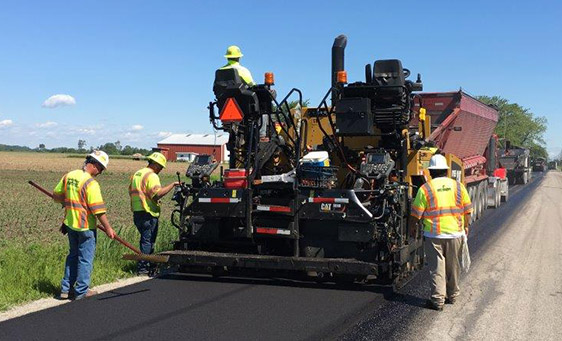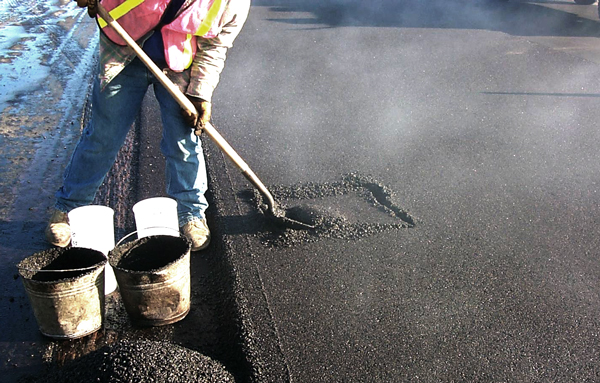Unlocking the Keys of Warm Mix Asphalt Modern Technology
Checking out the depths of hot mix asphalt technology uncovers a world where exact solutions and meticulous procedures merge to shape our roadways and facilities. The fusion of binders, fillers, and aggregates isn't simply a construction task but a strategic orchestration of toughness and performance.
Importance of Hot Mix Asphalt
Hot Mix Asphalt plays an important duty in modern-day infrastructure development due to its sturdiness and cost-effectiveness. As the most typically made use of paving material for roads, freeways, and car park whole lots, Hot Mix Asphalt offers a variety of advantages that add to its importance in building jobs. One vital benefit is its capability to endure rush hour lots and harsh weather conditions, offering a resilient and reliable surface area for transportation networks. Additionally, Hot Mix Asphalt is cost-efficient in both initial building and construction and lasting upkeep, making it a recommended option for many infrastructure tasks.
The durability of Warm Mix Asphalt comes from its make-up, that includes aggregates, binder, and filler products that are very carefully selected and blended to meet specific performance demands. This exact mix results in a versatile and strong sidewalk that can sustain frequent usage without significant damage. Warm Mix Asphalt is 100% recyclable, additional enhancing its sustainability and environmental advantages. Overall, the importance of Hot Mix Asphalt in framework growth can not be underrated, as it remains to be a keystone of modern-day building and construction techniques.
Parts of Asphalt Mixes
The make-up of asphalt mixes consists of carefully picked accumulations, binder, and filler materials that are important for attaining particular performance requirements. Aggregates are the main component of asphalt mixes, providing stamina and security. The binder, typically asphalt or asphalt cement, holds the accumulations together and gives versatility and resilience to the mix.
The mix and proportion of these parts play a substantial role in establishing the high quality and efficiency of the asphalt mix. Engineers carefully create the mix to meet details demands, taking into consideration variables like web traffic quantity, climate conditions, and sidewalk life-span. Appropriate selection and harmonizing of aggregates, binder, and fillers are vital for creating long lasting, long-lasting asphalt pavements.
Mixing and Manufacturing Techniques

When the aggregates are selected, the binder, usually asphalt cement, is contributed to bind the products with each other. The binder's quality and amount significantly affect the mix's adaptability, resistance, and strength to ecological variables. Additionally, fillers like moisturized lime or Portland concrete may be included to enhance certain attributes of the asphalt mix, such as its commercial parking lot paving workability or moisture resistance.
Throughout manufacturing, the aggregates and binder are warmed, commonly in between 250-325 ° F(121-163 ° C ), to help with blending and make certain correct finishing of the aggregates. The blending process needs to be thorough to achieve an uniform blend that advertises the desired efficiency characteristics of the asphalt. Different techniques, such as set blending or drum mixing, are used to achieve high-quality and constant asphalt mixes for building and construction tasks.
Variables Impacting Asphalt Efficiency
Aspects influencing asphalt efficiency incorporate an array of variables that influence the resilience, long life, and general high quality of asphalt sidewalks. One key aspect is the high quality of products utilized in the asphalt mix.

Design considerations, such as pavement density and water drainage, are vital in guaranteeing the lasting efficiency of the asphalt pavement. By meticulously taking into consideration these engineers, service providers and elements can optimize asphalt performance and boost the solution life of sidewalks.
Sustainable Practices in Asphalt Modern Technology

In addition, the growth of warm-mix asphalt (WMA) innovations has actually gotten traction in recent years. WMA permits the manufacturing and placement of asphalt blends at reduced temperatures contrasted to conventional hot-mix asphalt, resulting in decreased energy intake and greenhouse gas exhausts. Furthermore, using permeable asphalt blends can assist reduce stormwater drainage problems by enabling water to infiltrate with the sidewalk and into the ground, advertising natural water purification and recharge processes. By executing these sustainable methods, the asphalt sector can contribute to constructing a more eco-friendly and durable YOURURL.com framework network.
Conclusion
Finally, hot mix asphalt innovation plays an essential role in contemporary infrastructure development due to its resilience and cost-effectiveness. By very carefully balancing components, using appropriate mixing methods, and taking into consideration numerous elements, engineers can produce high-grade asphalt mixes that hold up against hefty traffic lots and harsh weather problems. Accepting sustainable techniques, such as using recycled materials and warm-mix innovations, even more boosts the ecological kindness of asphalt modern technology.
Blending and production strategies in warm mix asphalt technology include the precise combination and processing of aggregates, binder, and fillers to develop a durable and high-performance asphalt mix.Elements influencing asphalt efficiency incorporate an array of variables that influence the toughness, durability, and total quality of asphalt pavements. Lasting practices in asphalt innovation include different efforts intended at reducing the ecological influence of asphalt production and paving processes. By incorporating reclaimed asphalt pavement (RAP) and recycled asphalt tiles (RAS) into brand-new asphalt blends, the market can substantially lower the usage of raw products and energy, while likewise decreasing landfill waste.
WMA enables for the production and placement of asphalt mixes at lower temperature levels compared to traditional hot-mix asphalt, resulting in decreased energy intake and greenhouse gas exhausts.